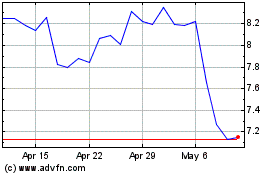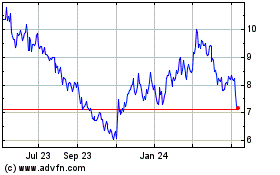Viemed Healthcare Comments on Final Report Issued by Office of Inspector General
May 24 2021 - 8:00AM

Viemed Healthcare, Inc. (the “Company” or “Viemed”) (TSX: VMD.TO
and NASDAQ:VMD), a home medical equipment supplier and the nation’s
largest independent provider of ventilation that provides
post-acute respiratory care services is commenting on a final
report and recommendation (“Report”) issued by the United States
Department of Health and Human Services Office of the Inspector
General (“OIG”) regarding an audit by OIG of claims relating to
one-hundred (100) of the Company’s non-invasive ventilation at home
(“NIVH”) patients. The Report is not binding on the Centers for
Medicare & Medicaid Services (“CMS”), and the Company has
received no indication that CMS intends to take any action to
recover the portion of purported overpayments that remain within
the CMS four-year look-back period. The Company would vigorously
contest any action by CMS given the shortcomings in the Report. The
Company has worked closely with CMS for years to establish formal
coverage guidelines for NIVH, and the Company intends to continue
to do so.
The Company firmly believes that the Report
ignores each patient’s diagnosis and supporting documentation of
that diagnosis from prescribing physicians, and applies clinical
guidelines that are contrary to CMS’s accepted standard of care. A
complete copy of Viemed’s response to the draft Report can be found
on page 35 of the report, at
https://oig.hhs.gov/oas/reports/region4/41804066.pdf. A summary of
the key points in the response follows below:
- The lack of clear guidance on the
use of NIVH for chronic obstructive pulmonary disease (“COPD”)
means that different government entities apply differing, and often
conflicting, standards on when NIVH is appropriate. This is
confusing for physicians, patients, and NIVH suppliers, and leads
to non-medical bodies like OIG substituting their alleged medical
judgment for that of treating physicians.
- Of the 100 claims audited by OIG,
42 claims were previously audited by CMS during a separate review.
As a result of that previous audit, CMS approved and paid 41 of the
42 claims. OIG subsequently failed all 42 of the claims. The Report
does not address this glaring inconsistency.
- As part of their treatment plan, 89
independent physicians around the country wrote NIVH prescriptions
and supplied medical records supporting that decision in a good
faith effort to provide NIVH for the 100 seriously ill patients
with chronic respiratory failure who were the subject of this
audit. These treating physicians believed NIVH was in the best
interest of their patients, but the OIG medical review contractor,
Maximus, which had no contact with patients except to briefly
review their charts years later, contradicted their physicians’
medical conclusions as to what was best for them.
- The OIG audit plan provided to
Maximus instructed Maximus reviewers to “explain why the medical
records did not justify treatment with a NHV,” showing that OIG’s
intent was to subjectively find ways to deny coverage to these
seriously ill patients.
- Applying OIG’s guidance that NIVH
is essentially never warranted would deny coverage for
life-extending therapy from an estimated 75,000 patients across the
country. This would actually increase the cost to CMS by requiring
patients to use repeat visits to the emergency room to manage their
diagnosed and documented end-of-life conditions.
“Viemed completely disagrees with the Report’s
findings and does not expect to receive an overpayment
determination from CMS,” said Casey Hoyt, Viemed Healthcare’s CEO.
“The Report shows how disconnected the investigators are from the
CMS Non-Invasive Ventilation clinical protocols and shines a light
on the lack of understanding of the critical role the DME industry
plays in providing life-saving care to COPD and Neuromuscular
patients with chronic respiratory failure. Our peer-reviewed
studies showing that NIVH is a cost-effective intervention that
improves survival and reduces hospital utilization could not have
been published at a more critical time as we need to continue
educating lawmakers and regulators on the value of NIVH in treating
chronic respiratory failure. We expect CMS to disregard the
recommendations contained in the Report, as they contradict
prescribing physicians’ and CMS’ own research-based guidance for
the DME industry. The Report will not alter the Company’s growth
strategy and we fully intend to maintain our course of reaching the
underserved population of chronic respiratory failure patients
across the United States. The Report illustrates why the Company
strives to work closely with CMS to formalize NIVH coverage
guidelines that align with CMS’ standard of care and, most
critically, allow patients with end-stage COPD to receive
appropriate care while remaining in their homes. Nothing in the
Report is unique to Viemed, and the OIG’s opposition to NIVH for
COPD in all circumstances is contrary to the medical research, CMS
Guidelines, and the independent medical judgment of treating
physicians across the country.”
ABOUT VIEMED HEALTHCARE, INC.
Viemed is a provider of in-home medical
equipment and post-acute respiratory healthcare services in the
United States. Viemed’s service offerings are focused on effective
in-home treatment with clinical practitioners providing therapy and
counseling to patients in their homes using cutting edge
technology. Visit our website at www.viemed.com.
For further information, please contact:
Glen AkselrodBristol Capital905-326-1888glen@bristolir.com
Todd ZehnderChief Operating OfficerViemed Healthcare,
Inc.337-504-3802investorinfo@viemed.com
Forward-Looking Statements
Certain statements contained in this press
release may constitute “forward-looking statements” within the
meaning of the U.S. Private Securities Litigation Reform Act of
1995 or “forward-looking information” as such term is defined in
applicable Canadian securities legislation (collectively,
“forward-looking statements”). Often, but not always,
forward-looking statements can be identified by the use of words
such as “plans”, “expects”, “is expected”, “budget”, “potential”,
“scheduled”, “estimates”, “forecasts”, “intends”, “anticipates”,
“believes”, or “projects”, or the negatives thereof or variations
of such words and phrases or statements that certain actions,
events or results “will”, “should”, “may”, “could”, “would”,
“might” or “will be taken”, “occur” or “be achieved” or the
negative of these terms or comparable terminology. All statements
other than statements of historical fact, including those that
express, or involve discussions as to, expectations, beliefs,
plans, objectives, assumptions or future events or performance,
including the Company's expectation that it will not receive an
overpayment determination from CMS based on the OIG Report and that
the Company will not be required to refund purported overpayments
described therein, are not historical facts and may be
forward-looking statements and may involve estimates, assumptions
and uncertainties that could cause actual results or outcomes to
differ materially from those expressed in the forward-looking
statements. Such statements reflect the Company's current views and
intentions with respect to future events, and current information
available to the Company, and are subject to certain risks,
uncertainties and assumptions. Many factors could cause the actual
results, performance or achievements that may be expressed or
implied by such forward-looking statements to vary from those
described herein should one or more of these risks or uncertainties
materialize. These factors include, without limitation: the general
business, market and economic conditions in the regions in which
the Company operates; the impact of the COVID-19 pandemic and the
actions taken by governmental authorities, individuals and
companies in response to the pandemic on our business, financial
condition and results of operations, including on the Company's
patient base, revenues, employees, and equipment and supplies;
significant capital requirements and operating risks that the
Company may be subject to; the ability of the Company to implement
business strategies and pursue business opportunities; volatility
in the market price of shares of the Company’s common shares; the
Company’s novel business model; the risk that the clinical
application of treatments that demonstrate positive results in a
study may not be positively replicated or that such test results
may not be predictive of actual treatment results or may not result
in the adoption of such treatments by providers; the state of the
capital markets; the availability of funds and resources to pursue
operations; decline of reimbursement rates; dependence on few
payors; possible new drug discoveries; dependence on key suppliers;
granting of permits and licenses in a highly regulated business;
competition; low profit market segments; disruptions in or attacks
(including cyber-attacks) on the Company's information technology,
internet, network access or other voice or data communications
systems or services; the evolution of various types of fraud or
other criminal behavior to which the Company is exposed; the
failure of third parties to comply with their obligations;
difficulty integrating newly acquired businesses; the impact of new
and changes to, or application of, current laws and regulations;
the overall difficult litigation and regulatory environment;
increased competition; changes in foreign currency rates; increased
funding costs and market volatility due to market illiquidity and
competition for funding; critical accounting estimates and changes
to accounting standards, policies, and methods used by the Company;
the Company’s status as an emerging growth company; and the
occurrence of natural and unnatural catastrophic events or health
epidemics or concerns, such as the recent COVID-19 pandemic, and
claims resulting from such events or concerns; as well as those
risk factors discussed or referred to in Viemed’s disclosure
documents filed with the U.S. Securities and Exchange Commission
(the “SEC”) available on the SEC’s website at www.sec.gov,
including the Company’s most recent Annual Report on Form 10-K, and
with the securities regulatory authorities in certain provinces of
Canada available at www.sedar.com. Should any factor affect the
Company in an unexpected manner, or should assumptions underlying
the forward-looking statements prove incorrect, the actual results
or events may differ materially from the results or events
predicted. Any such forward-looking statements are expressly
qualified in their entirety by this cautionary statement. Moreover,
the Company does not assume responsibility for the accuracy or
completeness of such forward-looking statements. The
forward-looking statements included in this press release are made
as of the date of this press release and the Company undertakes no
obligation to publicly update or revise any forward-looking
statements, other than as required by applicable law.
VieMed Healthcare (NASDAQ:VMD)
Historical Stock Chart
From Mar 2024 to Apr 2024

VieMed Healthcare (NASDAQ:VMD)
Historical Stock Chart
From Apr 2023 to Apr 2024
